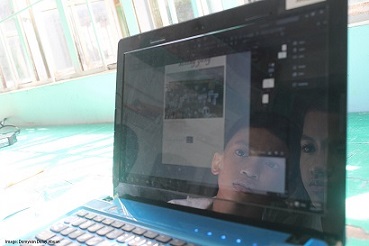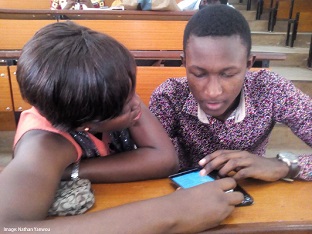By Manos Antoninis, Director of the Global Education Monitoring Report, and Silvia Montoya, Director of the UNESCO Institute for Statistics
This blog was also published by the Global Education Monitoring Report

This is why one of the monitoring indicators of Sustainable Development Goal (SDG) target 4.4, which focuses on “relevant skills, including technical and vocational skills, for employment, decent jobs and entrepreneurship” among youth and adults, looks at digital literacy. In particular, it calls on countries to track the percentage of youth and adults who have achieved at least a minimum level of proficiency in digital literacy skills.
Both the target and indicator reflect the commitment and forward-thinking of countries. But what exactly does it mean to achieve a minimum level of digital skills? Clearly the contexts will vary from one country to another. The challenge lies in finding a sufficiently broad definition that reflects these different contexts and priorities of countries while developing a measurement approach to generate the internationally-comparable data needed to monitor progress towards SDG 4.
This has been the priority of a task force of experts and country representatives, established by the Global Alliance to Monitor Learning (GAML) and chaired by the GEM Report. This work is crucial – we need a framework so that the UNESCO Institute for Statistics (UIS) can collect the data as the official source of SDG 4 indicators and internationally comparable education data and the Global Education Monitoring (GEM) Report can analyse the results and help keep countries and donors on track to achieve the goal. So we have been working together with the Hong Kong University’s Centre for Information Technology in Education (CITE) and the GAML task force to develop the first version of the Digital Literacy Global Framework.
Where to start

Digital literacy is the ability to access, manage, understand, integrate, communicate, evaluate and create information safely and appropriately through digital devices and networked technologies for participation in economic and social life. It includes competences that are variously referred to as computer literacy, ICT literacy, information literacy, and media literacy.
The next step involved a technical review of more than 40 digital literacy frameworks used by countries across all regions and income levels as well as those at the regional and international level. These different frameworks were mapped against the European Commission’s Digital Competence Framework for Citizens (DigComp 2.1).
Looking beyond DigComp
DigComp 2.1 was the subject of extensive research and consultation between many different countries but was obviously designed to reflect the situation in European countries. The review went a step further and focussed on the measurement frameworks used in low and middle income countries but also analysed the digital literacy skills used in major economic sectors, such as agriculture, energy, finance and transportation.
While DigComp 2.1 covers a wide range of competences, the conclusion is that it lacked two critical areas: (i) fundamentals of familiarity with hardware and software, which is often taken for granted in richer countries; and (ii) career-related competences, which would help make the generic competences more relevant to country contexts through practical examples of their use. The proposed global framework, which is available here in its draft form, covers a total of seven areas of competence presented in the table below. It responds to the call that the working group on education of the Broadband Commission made last September for an international framework on digital skills and competences.
Table 1. Proposed digital literacy competence areas and competences
|
Competence area |
Competences |
|
|
0. Fundamentals of hardware and software |
0.1 Basic knowledge of hardware such as turning on/off and charging, locking devices 0.2 Basic knowledge of software such as user account and password management, login, and how to do privacy settings, etc. |
|
|
1. Information and data literacy
|
1.1 Browsing, searching and filtering data, information and digital content 1.2 Evaluating data, information and digital content 1.3 Managing data, information and digital content |
|
|
2. Communication and collaboration |
2.1 Interacting through digital technologies 2.2 Sharing through digital technologies 2.3 Engaging in citizenship through digital technologies 2.4 Collaborating through digital technologies 2.5 Netiquette 2.6 Managing digital identity |
|
|
3. Digital content creation |
3.1 Developing digital content 3.2 Integrating and re-elaborating digital content 3.3 Copyright and licenses 3.4 Programming |
|
|
4. Safety |
4.1 Protecting devices 4.2 Protecting personal data and privacy 4.3 Protecting health and well-being 4.4 Protecting the environment |
|
|
5. Problem solving |
5.1 Solving technical problems 5.2 Identifying needs and technological responses 5.3 Creatively using digital technologies 5.4 Identifying digital competence gaps 5.5 Computational thinking |
|
|
6. Career-related competences |
6. Career-related competences refers to the knowledge and skills required to operate specialized hardware/software for a particular field, such as engineering design software and hardware tools, or the use of learning management systems to deliver fully online or blended courses. |
Note. Underscored competence areas and competences are proposed additions to the existing DigComp 2.1 competences.
The framework will also support efforts to develop indicators for SDG targets beyond education. Just last week, at the UN Statistical Commission meeting in New York, the Partnership for Measuring Information and Communication Technology for Development reported on the work of the UIS as a step forward in developing new sources of information, such as Big Data, to better track the use of ICT not just in education but also by households, businesses, trade as well as e-government and electronic waste.
Reflecting the priorities of countries at all income levels

This has important implications for the new framework. The first order of business is to provide a tool that countries can use to monitor progress towards SDG 4. But at the same time, the framework can also serve as a guide to help countries with very different contexts and needs target their policies, interventions and assessment of digital literacy. This is why a pathway mapping methodology was developed to help different stakeholders – including education planners, advocacy groups and concerned individuals – see the progression of different literacy skills using different types of devices when developing their own strategies and plans for digital literacy skills development.
Help us spread the word
The proposed global framework is now the subject of an online consultation. Today it is being presented at the 2018 World Summit on the Information Society in Geneva. Please send us your feedback and help us spread the word among your networks. With your support, this framework will help pave the way forward to the first globally-comparable indicators on digital literacy and how these critical skills are understood and assessed by countries around the world.
Leave a comment